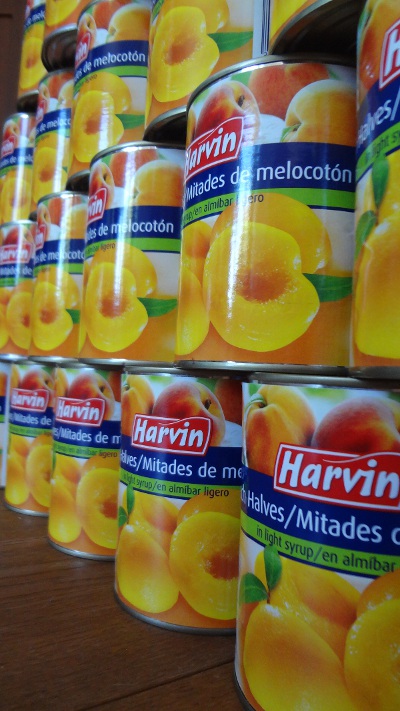Winemakers all over the world will probably hunt me down and lock me up in a deep dark prison cell far way from the outside world for writing stories like these. This is a story about peach wine. Even more horrific: Canned peach on syrup from Lidl, wine.
I have made this wine several times. It is not as easy as making wine from apple juice but it still is much easier than growing grapes, harvesting them, and making wine from them. For your ingredients you can go to a supermarket and buy them.
Since I have made it before I did not make the measurements again. I am sure that the values don’t change a lot.
What is the goal? How do we get there?
I would say that we want to make a white wine of approximately 12% and acidity 6. Since I made it before and liked it I am going to make 25L.
In the past I decided to use 1 can (820mL) per liter wine. You probably would be interested how I determined that. Unfortunately I cannot answer that. It was just a guess.
I measured the acidity in the past and it was about 3,5. So per liter I have to add 2,5 gm of tartaric acid to reach 6. This means 67,5 gm for 25L. Tartaric acid would not be my choice for a white wine so I would choose citric acid instead. Citric acid is more acidic than tartaric acid so I use approximately 85% which is 55 gm.
Then there is a slight problem. How do you determine the sugar content of a peach? The hydrometer and refractometer are not really an option for obvious reasons. But here you are saved by the manufacturer. It is written on the label! 13,5 gm sugar per 100 gm peach + syrup. (That is really a lot isn’t it?) Since the content of the can is 820 gm, each can contains 110 gm of sugar. Since I use 1 can per liter wine we have to add 108 gm sugar per liter for an alcohol percentage of 12%. Which is 2700 gm for 25L.
In the past I made the wine with a standard white wine yeast. This time I want to try it with champagne yeast because this type of yeast flocculates well and so far has given me very clear wines. (Which can be a bit of a problem with peaches)
I do not believe that yeast nutrition is necessary because of the amount of fruit. (If you have it, use it to be on the safe side.)
What I believe is a good thing, are pectolytic enzymes to help break down the cells of the fruit. If you don’t have them I am sure that you still can make this wine, but perhaps it will remain hazy, (Which is only an optical issue if you want to make it an issue) and give you more work.
So here is the list of ingredients:
- 25 cans of peaches
- 2700 gm sugar
- 55 gm citric acid
- pectolytic enzymes
- champagne yeast
And here is what you do:
- Sterilize 2 buckets with sulphite and citric acid solution.
- Leave the solution in 1 of the buckets for cleaning (and blending) purposes.
- Put a teaspoon of sulphite in the other bucket (approximately 2.5 gm) for security.
- Open a can and pour the liquid (not the peaches) in the bucket with the teaspoon of sulphite so the blender can fit in the can.
- Place the can in the bucket with the sulphite solution (to sterilize the outside of the can) and use a blender to mash the peaches. Repeat this with the 25 cans. Try not to overheat the blender. Most of them are not made for these quantities.
- Boil a few liters (Not too much) water and dissolve the sugar and citric acid. Mix it with the blended peaches.
- Add a few tablespoons of the pectolytic enzymes and mix them with a clean spoon.
- Leave the bucket for a night or more so the enzymes have time to do their destructive duty.
- Hydrate the yeast as usual and pour it over the peaches.
Since there are many fruit particles in the most you need plenty of headspace in the bucket, and you need to shake the bucket a few times per day to mix the floating fruit back in the fluid.
After about 2 weeks the not so nice part starts. You have to filter out the fruit. So far I have not found an easy way to do it. (I did recently) The fruit particles are so fine that they clog up a filter (or cheese cloth) very quickly. So take your time and remind yourself that it is for a good cause. After filtering, add water to 25L.
This is one of the wines that I rack a few times because it contains so many small particles that take their time to settle. You need patience for this wine but I think it is worth it.
The result.
Unfortunately I do not have a picture of the previous versions. But I still have my notes!
“It took a long time to become clear and produced a lot of sediment. It actually did not completely clear up in the demijohn but in the bottles which contained some sediment.
Because of the long time it took to make this wine it became special. It aged well. It was a very good white wine with a slight aroma of apple. You can barely taste that it was made from peaches but when I tell my guests that it is they recognize it. It is a fruit wine that is very accessible to the “normal” wine drinker since the taste is very similar to “normal” wine.”
Try it and may the patience be with you.
Hans


